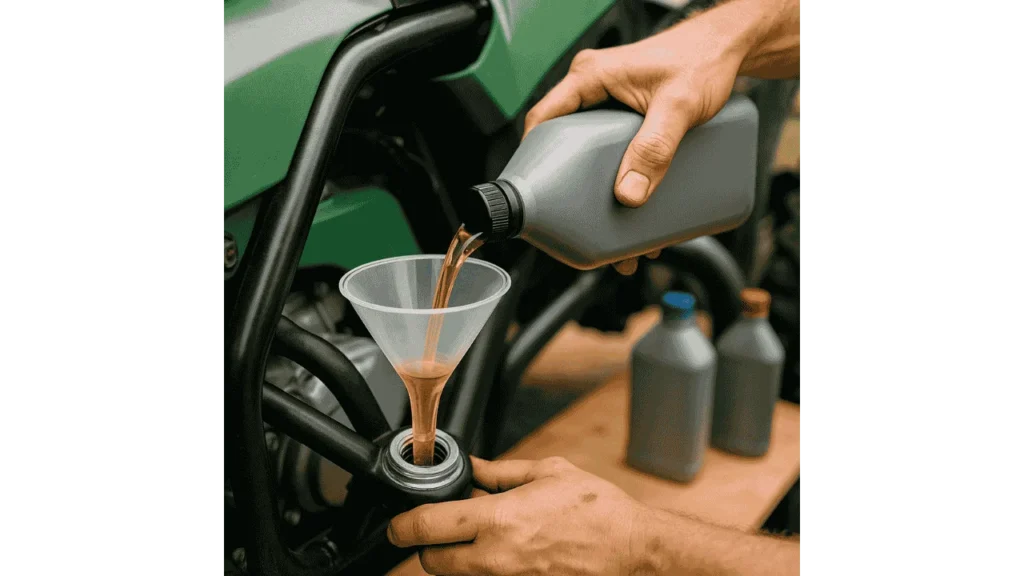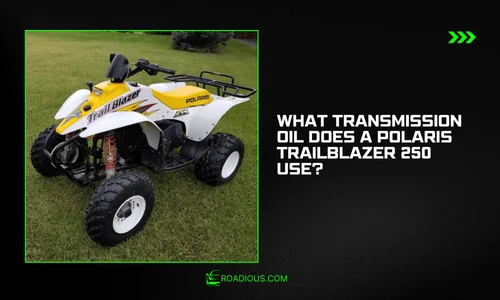A Polaris Trailblazer 250 thrives on gnarly trails only when its transmission bathes in the correct lubricant. The fluid you pour today determines how smoothly gears mesh tomorrow—choose poorly and friction, heat, and metal shavings arrive sooner than any rider wants. Below you’ll find a clear explanation of why factory‑spec oil matters, which alternatives are safe, and how to service the gearbox so your quad keeps pulling hard for years.

Why Does Transmission Oil Matter?
Inside the Trailblazer’s gearcase, helical gears spin at high RPM while constant‑velocity shafts transmit power to the wheels. Proper transmission oil cushions these surfaces, disperses heat, and suspends microscopic metal debris until the next change. Skip the right viscosity or overlook additives and you invite worn dogs, scorched seals, and costly rebuilds. Lubrication engineer Dr. Carina Voss puts it plainly:
“In an ATV transmission, oil is both coolant and shock absorber. Use the wrong blend and you lose both protections in one mistake.”
Factory‑Recommended Fluid
Polaris engineers formulated AGL (Angle Gearcase Lubricant) Synthetic specifically for gearcases like the Trailblazer 250. Its film strength, friction modifiers, and anti‑foaming agents match the clutch and dog‑engagement forces inside the box. Using AGL preserves warranty coverage and lengthens interval spacing because its high‑temperature stability resists shear better than generic gear oil.
Safe Alternative Oils
Trail repairs or remote locations sometimes force riders to improvise. If AGL is unavailable, reach for a quality 80‑weight GL‑4 synthetic ATV gear oil listed as wet‑clutch compatible. Avoid GL‑5 automotive fluid; its sulfur‑phosphorus additives can pit bronze thrust washers. Veteran race mechanic Leo Hernandez advises,
“Match the GL‑4 spec first, viscosity second. Anything else is gambling with soft‑metal bushings.”
How to Change the Fluid?
Allow the engine to idle for two minutes—the warm oil drains faster and carries contaminants with it. Park on level ground, remove the 13‑mm drain bolt, and let the old fluid pour into a pan. Inspect the magnetic tip for more than a light paste of filings; shards mean gear damage. Reinstall the plug with a fresh crush washer, then add the specified volume of fresh oil through the filler neck. Check the sight glass or dipstick to confirm the level lands between marks, not above.
Learn More: Honda UTV vs Polaris UTV
Service Intervals and Pitfalls to Avoid
Polaris recommends a fluid change every 20 hours of severe riding or annually, whichever comes first. Submerged creek crossings or muddy excursions shorten that clock because water infiltration turns lubricant milky, slashing film strength. Common owner mistakes include topping off with mixed brands, overfilling (which whips air into oil), and reusing crush washers that fail to seal on the second torque.
Red Flags Indicating a Needed Change
A gearbox that suddenly whines, clunks into gear, or leaves metallic sparkles on the dipstick is flagging worn fluid. Burnt‑oil smells after a long pull uphill also warn that viscosity has broken down. Treat any of these signs as an immediate call for a drain‑and‑fill rather than waiting for scheduled service.
Benefits of Using the Correct Oil
Sticking with factory‑spec fluid guarantees consistent shift feel, cooler operating temps, and extended gear life. Correct lubrication translates into fewer parts replacements and improved fuel efficiency thanks to reduced drag. Over the long haul, the pennies saved on bargain oil rarely match the dollars spent on premature rebuilds.
Read More: Polaris vs Can-Am UTV: Which One Should You Choose?
Conclusion
Your Polaris Trailblazer 250’s transmission lives or dies by the oil inside it. AGL Synthetic meets every engineering requirement, and GL‑4 synthetic ATV oil makes a viable stand‑in when the real thing is unobtainable. Adhere to the recommended change intervals, avoid mixing fluids, and inspect the magnetic drain plug at every swap. Follow those simple habits, and the Trailblazer’s gearbox will outlast countless trail adventures, delivering the crisp engagement and unflinching torque that Polaris riders expect.





